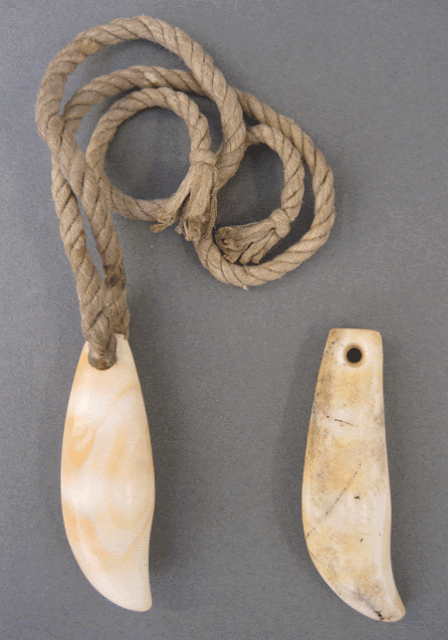George Forster, in 'A Voyage Round the World' notes that the inhabitants 'looked almost black, being punctured (tattooed) over the whole body.' Some of them, once they had sold their fruit and vegetables to the sailors on board the Resolution, 'came on board to be gazed at, and to gaze.' Forster also described the many ornaments worn by the Marquesans, observing that 'the number of ornaments, in some measure, might be said to supply the want of clothing.' He went on to say that some 'wore a string around the neck, and fastened to it a piece of shell, which was cut and polished in the shape of a large tooth.' (See George Forster, 'A Voyage Round the World', N.Thomas and O. Berghof (Eds) Vol.1. University of Hawaii Press, Honolulu, 2000).
There are two of these shell ornaments in the Cook-voyage collections at the Pitt Rivers, collected by the Forsters. In the 'Catalogue of Curiosities' they are numbers 139 and 140, 'Two bones (or teeth of porpoises?) hung before the neck.'
 |
| 1886.1.1540 (left) and 1886.1.1541 (right) |
The pendants are made from shell, probably from the mouth of a helmet shell (Cassidae sp.) They are carved to resemble whales teeth, which were a valuable commodity on the Marquesas, and reserved only for those of high status. The Marquesas had few fringing reefs, and few sperm whales were stranded there, as occurred elsewhere in Polynesia. The fact that shell was carved to resemble whale teeth (skeuomorphs - objects made from one material in the form of another) shows how important whale ivory was to the Marquesans. The cord is made from strands of barkcloth, which have been twisted together.
See also Steven Hooper, 'Pacific Encounters, Art and Divinity in Polynesia 1760-1860' British Museum Press, 2006, and Eric Kjellgren with Carol S. Ivory, 'Adorning the World - Art of the Marquesas Islands', Metropolitan Museum of Art, 2005.